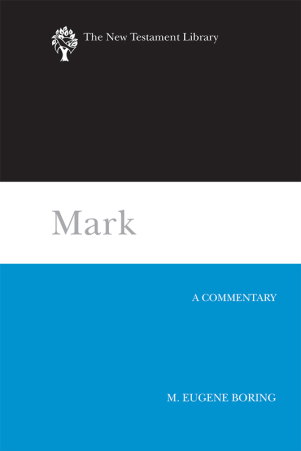
This week Accordance Bible Software has released a massive 68-volume bundle from Westminster John Knox Press: the Old Testament Library and New Testament Library.
The whole bundle, which is also available in component parts, includes a full set of 31 Old Testament commentaries, a series of 15 New Testament commentaries, and topical monographs for both Testaments. Here’s an article from Accordance on the release. In this post I interact with the bundle, as well as provide a short video demonstration of how to smartly search the modules via different search fields.
Sample Passage: Mark 12:13-17 (Among Others)

Nothing against commentaries that draw on an established translation, but I appreciate commentaries (like this one) where the author offers an original translation with explanatory footnotes.
Here’s Mark 12:13-17 in Eugene M. Boring’s original translation:
12:13 And they are sending some of the Pharisees and Herodians to him, to set a verbal trap for him. 14 And they come and say to him, “Teacher, we know that you are truthful and answer without regard to what people may think, for you show no partiality, but teach the way of God in accordance with truth. Is it right to pay the poll tax to the emperor, or not? Should we pay it, or should we not?” 15 But knowing their hypocrisy, he said to them, “Why are you putting me to the test? Bring me a denarius and show it to me.” 16 And they brought one. And he says to them, “Whose image is this, and whose title?” They answered, “The emperor’s.” 17 Jesus said to them, “Give back to the emperor the things that belong to the emperor, and to God the things that belong to God.” And they were utterly astounded at him.
This section reads well enough. Note that Boring translates the beginning of the verse
Καὶ ἀποστέλλουσιν πρὸς αὐτόν τινας τῶν Φαρισαίων καὶ τῶν Ἡρῳδιανῶν
as
And they are sending some of the Pharisees and Herodians to him….
The “and” is translated (better, I think) in other versions as “then” (NRSV) and “later” (NIV). And I don’t find compelling reason in an English translation to preserve Greek’s “historical present” (ἀποστέλλουσιν) as “they are sending,” when the passage is describing a past narrative event. Formal English narrative prose wouldn’t be expected to use historical present. So, too, with verse 14’s, “And they come and say to him….” But that doesn’t overshadow Boring’s exegetical prowess!
For the second part of verse 13, ἵνα αὐτὸν ἀγρεύσωσιν λόγῳ, Boring provides a nice explanatory footnote:
The dative / instrumental logō, without preposition or pronoun, can refer either to what the inquirers say, “with a question,” or what they try to get Jesus to say, “in what he said.”
The translations throughout the OT and NT Library are strong in this regard—the authors highlight other options and why they chose what they did, focusing on lexical and grammatical challenges as they arise.
OTL and NTL are full of historical background:
While in the Markan story line the whole scene is part of the effort to find grounds on which Jesus may be arrested, the question itself, and Jesus’ response to it, is also inherently important for Mark. It was a live issue in his own time, in which the relation of Christians to the demands of the Roman government was not an abstract problem.
And more:
The denarius was a Roman coin, bearing the image of the emperor and an inscription declaring him to be divine and pontifex maximus (high priest). Not only the image, but the inscription, would be offensive to Jewish sensibilities.
In addition to focus on grammatical-historical detail, the series is refreshingly theological in a way that keeps the wider biblical witness in view for a given passage. Here’s more of Boring on this passage in Mark:
There is no paralleling of Caesar and God. God is God and Caesar is not God, in direct opposition to the image and title on the coin. The world is not divided into two parallel kingdoms. There is no encouragement in this text for dividing the world into “secular” and “sacred,” with Caesar ruling the one and God the other, nor is there any “balancing” of civic obligation to the state and religious obligation to God. Obligation to God overbalances all else (cf. 12:44, which concludes this section). Caesar is relative and God is absolute, so the two statements are not on the same plane; the second relativizes the first. Even the conjunction kai that joins them is not coordinating but adversative (as, e.g., Rom 1:13). Caesar does have a kingdom, and Jesus’ followers live in it, but God is the creator of all, and God’s kingdom embraces all, including that of Caesar. Thus while the saying itself calls on Jesus’ hearers to give both Caesar and God their due, it is not directed to those situations in which one must choose between God and Caesar as Lord. When those situations arise, devotion to God must clearly take precedence over Caesar; God demands all (12:29–30; cf. Acts 5:29). But the saying does not tell the hearer in advance how to discern what those situations are.
(His honesty and humility are refreshing!)
Again, the attention given to the passage in its wider literary-biblical context is a hallmark of the series. Here is Stephen E. Fowl on Ephesians 4:1 (“As a prisoner for the Lord, then, I urge you to live a life worthy of the calling you have received”):
Paul’s exhortation to the Ephesians is that they walk in a manner worthy of their calling. The use of the term “to walk” to characterize a way of life already appeared in 2:2, to refer to the Ephesians’ moribund way of life outside of Christ. In 2:10 it is used to speak of the manner of life that God has prepared for believers, further connecting chapters 1–3 and 4–6. Here in chapter 4 the initial admonition to the Ephesians is to “walk in a manner worthy of the calling with which you have been called.” The standard to which the Ephesians’ common life should conform is the “calling with which they have been called.” This calling is first mentioned in 1:18, but it is really in 2:1–10 and 11–22 where the shape of this calling is developed. Recall that in chapter 2 the Ephesians learn of their deathly state in God’s purview and outside of Christ, yet also of how God has graciously delivered them from death into life in Christ so that they may walk in the good works that God has prepared for them. Hence, Paul is not setting some new standard for them. Rather, he is reminding them of what God has already done on their behalf.
When it comes to critical issues like authorship, the volumes I’ve interacted with take a balanced approach. Here’s Fowl, again, on Ephesians:
The overwhelming majority of people read Ephesians for broadly theological reasons. That is, they read Ephesians because it is indisputably a part of Christian Scripture, and Christians by virtue of their identity are called to a lifelong engagement with Scripture as part of their ongoing struggle to live and worship faithfully before the triune God. Christians read Scripture in a variety of ways and in a variety of contexts to deepen their love of God and love of neighbor. Given the ends for which Christians engage Scripture theologically, the issue of authorship is not particularly relevant. Ephesians plays the role it does in the life and worship of Christians because it is part of the canon, not because it is written by Paul or not written by Paul. The text is canonical, Paul is not.
There are some real standouts in the series: Gerhard von Rad on Genesis, Brevard S. Childs on Exodus and Isaiah, Leslie C. Allen on Jeremiah, Adele Berlin on Lamentations, Luke Timothy Johnson on Hebrews, and more. I wish I’d had this Berlin volume as I preached through Lamentations last Lent! (I did access some pages via Google Books preview.)
VIDEO: Using Search Fields in Accordance
How about the OT/NT Library in Accordance specifically? In April I made a 12-minute screencast (just for fun… and for free!) that explains how to read a book in Accordance. I highlight four features that you won’t find on Kindle or that aren’t possible in print. (Here’s the link.) All that I highlight in that video is true of just about any tool in Accordance.
In the below video, I take a shorter time (if you don’t have 12 minutes) to highlight just one feature that sets Accordance apart from other software: search fields.
Where to Get It
For a few more days, the OT/NT Library is on sale through Accordance.
The OT/NT Library is also available as individual commentaries, if you want to pick up just the volume covering whatever book you’re studying or preaching on now.
You can read more about the new release here, which includes hyperlinks to the full bundle, the smaller bundles, and individual volumes. And be sure to check out Wes Allen’s review here!
Thanks to the PTB at Accordance for providing me with free access to the OT/NT Library in exchange for a review. This provision did not influence my assessment of the series! See my other Accordance posts (there are many) gathered here. I recorded the video using the app Capto.
































